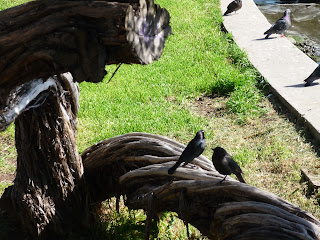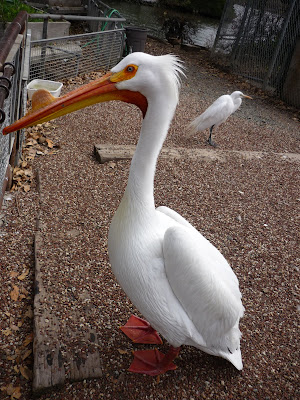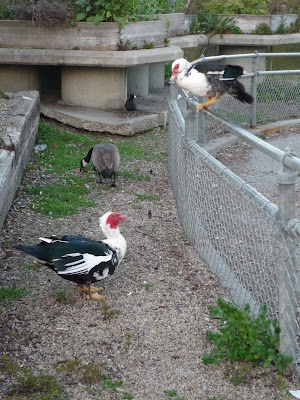 I got a good healthy dose of wildflowers, oak trees, and green rolling hills this weekend up at Briones Regional Park. I was hoping for more wildflowers actually, but we at least found some lupine, buttercup, and poppy... the usual. A few bird friends came out to play as well:
I got a good healthy dose of wildflowers, oak trees, and green rolling hills this weekend up at Briones Regional Park. I was hoping for more wildflowers actually, but we at least found some lupine, buttercup, and poppy... the usual. A few bird friends came out to play as well: Here's a Black Phoebe doing the phoebe thing--sallying. They lurk on a branch or bit of barbed wire like the creepy flystalkers they are. And when they see a tiny little flying lunch--
Here's a Black Phoebe doing the phoebe thing--sallying. They lurk on a branch or bit of barbed wire like the creepy flystalkers they are. And when they see a tiny little flying lunch--
--off they go in pursuit. The phoebe's family is the flycatchers, and even in other languages their name captures this habit. In Italian it's an acchiappamosche (catches-flies) or a pigliamosche (takes-flies). After it nabs the little doodad, it's back to the perch:
 (I took this picture by putting the camera up to the binocualrs! Lowest-tech.) Phoebes sally. Two girl names for one little birdy.
(I took this picture by putting the camera up to the binocualrs! Lowest-tech.) Phoebes sally. Two girl names for one little birdy.Then we saw a fence lizard trying to become a tree-lizard:
 And after poking around in a dead fallen tree, Tom found some weird orange things that might be eggs:
And after poking around in a dead fallen tree, Tom found some weird orange things that might be eggs:
And a centipede:
 You can tell it's a centipede because it has 100 legs, all of which it is willing to use to murder your babies. If you're a sowbug anyway.
You can tell it's a centipede because it has 100 legs, all of which it is willing to use to murder your babies. If you're a sowbug anyway.Now for some forensics: MORE DEAD THINGS ALERT:
We smelled a skunkety skunk skunk while hiking, and that made us look around for the source of the smell. And we found it:

Ok, now here is what's super freaky about this. That thing on the right that looks like a possum tail? That's the spine. That pink thing on the left, near the stick? That's the skull, with the nose-end still in the skin and the rear part (the occipital and parietal) skinned and bare. And in the middle are some leg bones, paws, and an inside-out, holy skunk skin, Batman! Help us, Sherlock Bones! What kind of predator would do this? How could it do it without thumbs!? It is very weird. The internet is inconclusive on this subject, and as I often find, all the real knowledge is locked away behind JSTOR or other things that you have to pay for in order to get access. Wikipedia, HMPH. You can't answer THIS mystery.

Here is what I was able to piece together:
--Bears often turn their prey inside out and so do sea lions. Neither is a candidate in Briones.
--Coyotes, bobcats, and possibly foxes are big enough to kill a skunk, but would likely bury or at least move the carcass from the side of the trail where it was killed. So, they are probably not the killers.
--Racoons could probably kill a young skunk, but I didn't find any descriptions where they turned their prey inside out.
--Great Horned owls are known to kill skunks, but I couldn't find descriptions of what parts of the skunk they would eat, or what they might do to the carcass.
--Eagles are also said to skin out their prey like this, as well as leaving talon-holes in the skin. Although I've never seen one, eBird has sightings listed of Golden Eagles in Briones. However, they are also supposed to leave white streaks of poo everywhere around the carcass, which we did not observe.
Well, until I get a chance to dig deeper into some better documentation, this will remain a mystery for now. And now, just so you don't have nightmares about decapitated skunks, here's a little scrub jay and blue sky. SLEEEEEEEP! AND FORGEEEEEET....









































